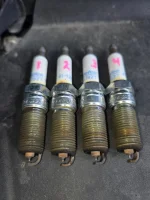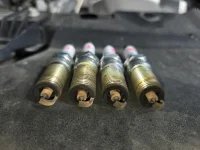I'll be quite surprised if the tire inflation has been your issue for 2 years. I'd either throw plugs in it, or get a decent scanner that lets you see misfire counts live.
As I posted before, I replaced stock plugs just before 40,000 miles from an idle misfire. I went with the 2 step colder plugs that are often recommended on LTG boards. By about 65,000 miles I had a mid throttle misfire, mostly when the engine was cold-ish (<5 or 6 min of driving). No codes, no stored codes, etc. Live monitoring showed what I was feeling was multiple misfires across all the cylinders pretty randomly, but never enough within the time window to throw a misfire code (I don't know the thresholds, but say 6 misfires from 1 cylinder in 5 seconds, or something). New stock plugs cured it. I'd say the colder plugs are maybe good if modded and driving the car fairly hard. Winter commuting in Michigan? They don't self clean well at those cylinder temps.







